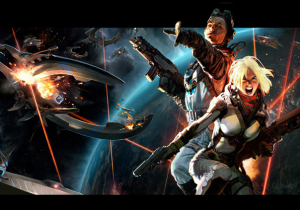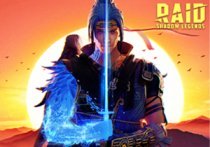2014 MMO Predictions – The Rise of Non-Linear MMOs

By Michael Sagoe (mikedot)
2013 sure was a shaky year.
Many MMO titles have fallen on and off the radar.
Many F2P MMOs have been shut down.
And World of Warcraft continued its tight stranglehold on the entire industry.
But today, it’s becoming more apparent that gamers are getting burnt out on MMOs altogether. Mainly due to years of conditioning brought by World of Warcraft, many titles have been forced to follow its formula down to a T, as well as follow a strict check list for progression, features and amount of control the player has up until the endgame. For any MMO that doesn’t have a massive amount of content like World of Warcraft, it’s a formula that becomes a time bomb for any MMO attempting long term development.
Previously at GDC 2013, Park Seong Joon of Neowiz CRS hosted a lecture regarding the pitfalls of maintaining a modern MMO, with average scenario that happens after an MMO has launched:
Wonky grammar aside: his lecture explains that most players will burn through the content of a new MMO faster than any development team can crank out new content for it, since many gamers have been convinced that the endgame is where all the “fun stuff” happens, rather than the stuff that comes before it. With the linearity that most modern MMOs have, they’ll get bored as soon as they realize that the endgame actually has an –end- to it. While there are plenty of people that play MMOs at a more casual pace these days, it’s a routine that I see time and time again.
What ends up happening in the long run is that post-launch development will take too long to create, so developers will have to focus most of their time and effort on various cash grabs and/or events in order to sustain themselves and their playerbase, rather than expanding on the game. Perfect example would be TERA: Rising. When it first launched, many exciting features were planned for post launch including a level cap raise, the northern Arun continent and PvPvE content called the “Juras Ark” where players would fight over floating fortresses in the sky. However, the launch was lacking a considerable amount of content including structured PvP like the Fraywind Battlegrounds. Many players got bored after hitting the level cap, player numbers dropped, development costs and time became too much for the development team to handle, and what the remaining players received was a far less ambitious version of all those planned features.
The Alliance Update serves as the remains of what the Juras Ark update could have been.
So how do we help prevent players from leaving an MMO due to exhausting content? One answer that many developers have concluded on is that we need to start looking back towards the past. Back to a time when MMOs were still exploring different possibilities with their gameplay design and how much control the player should have over their gameplay experience. Games like Ultima Online, early Ragnarok Online, Runescape Classic, Graal Worlds, Saga of Ryzom, early Star Wars Galaxies… While these games still gave players a sense of conveyance and rules on what players could do and where they could go, players were (for the most part) free to do what they wanted, when they wanted, without the game nagging them to progress by upping their stats and gear score. With this, most players were less fixated on the endgame destination and more focused on the journey, and the social experience that comes with it.
Although what players could do back then was considerably limited due to outdated game design, technology has come a long way since then. Today’s game developers are far more capable of taking a simple concept and doing so much more with it.
Simply put: MMOs should be leaning towards player made experiences and freedom of choice. A handful of game developers have realized that this is a more sound way to create an MMO, and while the initial costs and time for development will be fairly high, it will be worth it to have a lot more time to create new content afterwards as players create their own content and experiences, which could easily keep them busy for longer than a month or two.
The trend already started picking up in 2013, with a handful of non-linear MMOs in development along with some already nearing release. Titles like ArcheAge, Everquest Next / Landmark, Black Desert, Life is Feudal, Peria Chronicles, Star Citizen, The Repopulation, Camelot Unchained, Albion Online and many more. This is why I predict that 2014 will solidify the trend and become the new standard for MMOs going forward.
Now I’d like to take a moment to point out that I did not list these titles as “sandbox MMOs”, even though many of them categorize themselves as such. The reason I say this is because all MMOs, including theme park ones, are very capable of providing an enjoyable, non-linear experience. The advantage of theme park MMO design is that developers can plan everything more accordingly around the activities and paths that each player decides to take. Once more: Technology has come a long way, so players can enjoy an open-ended experience in a theme park MMO just like in any sandbox one.
Take DevCat’s Mabinogi for an example: While it is considered a theme park MMO in every sense of the term and now has more of a straight forward progression path laid out for new players, it has enough content and features to give players enough freedom to experience the game in many different ways. Even during Mabinogi’s early days when there wasn’t a lot of content available, players themselves were happy with exploring the world, crafting items, socializing in town, starting campfires and playing songs for each other, rather than trying to complete the mainstream story quests and the “Best-in-Slot” equipment as fast as possible.
Another upcoming MMO that’s said to be merging the line between linear and non-linear experiences is none other than the highly anticipated WildStar from Carbine Studios. Back in 2012, Jeremy Gaffney of Carbine Studios posted a news update on the official WildStar homepage, stating that both theme park and sandbox elements will be introduced into their game:
“In most zones, there is an overall ‘theme park’ overlay – a main quest line that brings you through the zone, has some clear story to it, and is strongly directed. So you always have a guidepost for where you “need” to go (you can skip it, but most people do it). But in the same area, you can find random quests that are either dynamic (through discoveries, for instance), or some zones have elements like poachers who might get bored, build camps, and then there is a prisoner in the camp with a quest for you.”
“Because those random quests come from a static “pool” they are only semi-sandbox-y. But at some point you get a critical mass of quests that might appear that make the area really feel dynamic. We’re experimenting with areas at the higher levels that are almost purely dynamic – we’ll see if they feel great or if they still need that high-level theme park direction as we go into beta.”
However in more recent news, Carbine Studios has stated that they will have a strong focus on endgame content as well, so it will be interesting to see if they can balance all these pieces together.
Overall, 2014 has a better chance of being a memorable year for MMOs in general, and I’m certainly going to have a lot of fun sifting through each new arrival to see which one truly hits the mark. Who would have thought years back that the future of MMOs would lie in the past, which will soon be the present…?
That’s almost mind blowing.
Articles You May Enjoy
- Robocraft supports MegaBots' Kickstarter campaign
- In support of this project, Robocraft have created a battle-ready, virtual robot of the MegaBots MK.II in their game.
- Maestia Announces Open Beta Date
- Gravity Interactive has announced the open beta launch date, plus a new trailer, for Maestia.
- SMITE Cosplay Gallery from Season 2 Championship + Giveaway
- Hey community! I've just returned from the SMITE World Championships and come bearing gifts of cosplay shots galore!

















